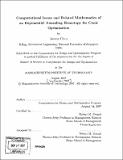Computational issues and related mathematics of an exponential annealing homotropy for conic optimization
Author(s)
Chen, Jeremy, S.M. Massachusetts Institute of Technology
DownloadFull printable version (3.330Mb)
Other Contributors
Massachusetts Institute of Technology. Computation for Design and Optimization Program.
Advisor
Robert M. Freund.
Terms of use
Metadata
Show full item recordAbstract
We present a further study and analysis of an exponential annealing based algorithm for convex optimization. We begin by developing a general framework for applying exponential annealing to conic optimization. We analyze the hit-and-run random walk from the perspective of convergence and develop (partially) an intuitive picture that views it as the limit of a sequence of finite state Markov chains. We then establish useful results that guide our sampling. Modifications are proposed that seek to raise the computational practicality of exponential annealing for convex optimization. In particular, inspired by interior-point methods, we propose modifying the hit-and-run random walk to bias iterates away from the boundary of the feasible region and show that this approach yields a substantial reduction in computational cost. We perform computational experiments for linear and semidefinite optimization problems. For linear optimization problems, we verify the correlation of phase count with the Renegar condition measure (described in [13]); for semidefinite optimization, we verify the correlation of phase count with a geometry measure (presented in [4]).
Description
Thesis (S.M.)--Massachusetts Institute of Technology, Computation for Design and Optimization Program, 2007. Includes bibliographical references (p. 105-106).
Date issued
2007Department
Massachusetts Institute of Technology. Computation for Design and Optimization ProgramPublisher
Massachusetts Institute of Technology
Keywords
Computation for Design and Optimization Program.